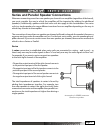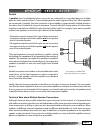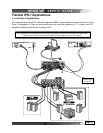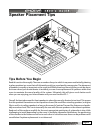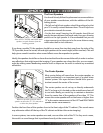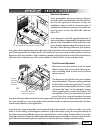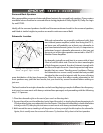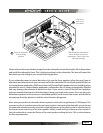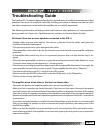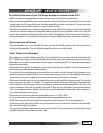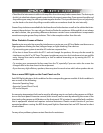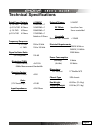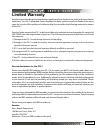
Page 24
Page 25
Troubleshooting Guide
The Emotiva IPS-1 is expertly designed and built to provide years of trouble-free performance. Most
problems that occur can usually be solved by checking your setup or making sure that the audio
and video components connected to the amplier are on and fully operational.
The following information will help you deal with common setup problems you may experience
during normal use of your unit. If problems persist, contact your Emotiva Dealer for help.
No Sound (from one or more speakers connected to the IPS-1)
• Speaker cables may have come undone. Turn o your system and check the cables, and tighten the
amplier and speaker binding posts.
• The system may have one or more damaged audio cables.
• The preamplier volume level is low for the channels concerned. Recheck the preamplier calibration
procedure.
• A preamplier Mute switch may be on, or an external processor loop or a tape monitor loop is en-
gaged.
• Check that your preamplier or source is running the correct surround sound mode. Maybe it is set for
2-channel stereo when you were expecting 5.1 surround sound.
• Check in case any missing channels have been turned o in a preamplier setup menu. For example, the
center amplier channel will not receive a signal if the preamplier has been set to “Phantom.”
• The Auto/on/o switch on the IPS-1 might be in the OFF position.
• Check to see that the ON/OFF rocker switch at the back of the unit is in the ON position.
• The fuse on the unit may have blown .
The amplier shuts down often or the line fuse blows often
• Check that the positive and negative speaker wires are not shorted together.
• Make sure that no speakers are shorted internally. If you have an ohm-meter, disconnect the speaker
wires and measure the resistance between the speaker’s positive and negative terminals. If the reading
is less than 2 ohms, the speakers may have an internal short or simply be too low a nominal impedance.
Measure all speakers and check their impedance specications for compliance with the IPS-1 operational
characteristics.
• If you have connected speakers in parallel, the overall impedance may be too low. It is recommended
that you rearrange the speakers in series to increase the overall impedance, thus taking some of the
load o the amplier.
• Make sure that the amplier has good ventilation and is not overheating. Allow good airow under-
neath wherever possible. If the amplier is in a closed rack, open up the rear panel or use a quiet fan for
improved ventilation.



